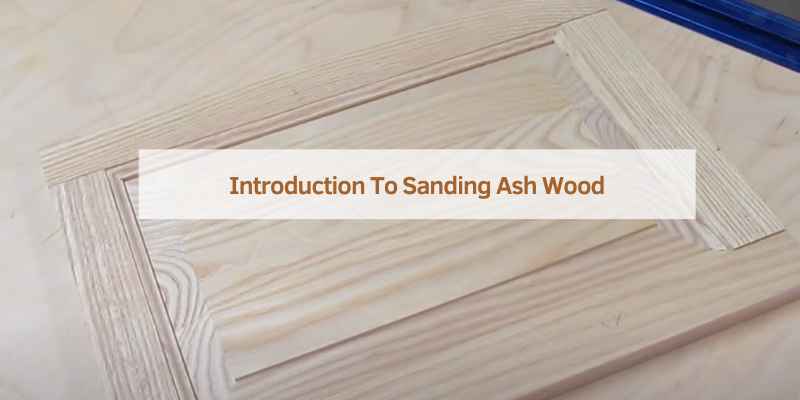To sand ash wood, start with coarse sandpaper and gradually switch to finer grits for a smooth finish. Sand in the direction of the wood grain for best results.
Sanding ash wood is a crucial step in woodworking projects to achieve a polished and professional look. By following the proper sanding techniques, you can enhance the natural beauty of the wood and prepare it for staining or finishing. Whether you are working on furniture, flooring, or any other ash wood project, knowing how to sand effectively will ensure a high-quality end result.
In this guide, we will explore the best practices for sanding ash wood to help you achieve a flawless finish.
Introduction To Sanding Ash Wood
Discover the art of sanding ash wood to achieve a smooth finish. Start with coarse grit sandpaper, gradually transitioning to finer grits for a polished look. Remember to sand in the direction of the wood grain to avoid any scratches or imperfections.
Sanding ash wood is an essential step in woodworking projects to achieve a smooth and flawless finish. Ash wood, known for its strength, durability, and beautiful grain patterns, is a popular choice for furniture, flooring, and cabinetry. However, before you can fully appreciate its natural beauty, proper sanding is crucial. In this guide, we will explore why ash wood is a preferred material, the key benefits of sanding it correctly, and provide you with practical tips to ensure a successful sanding process.
Why Ash Wood?
Ash wood is highly regarded in the woodworking industry for several reasons. Its unique characteristics make it an excellent choice for various projects. Here are a few reasons why ash wood stands out:
- Strength: Ash wood is known for its exceptional strength and resilience, making it suitable for furniture that requires durability.
- Grain Patterns: The distinct grain patterns of ash wood add visual interest and depth to finished products, enhancing their overall appeal.
- Workability: Ash wood is relatively easy to work with, allowing woodworkers to shape, carve, and join it with ease.
- Availability: Ash wood is widely available, making it accessible for woodworking projects of all scales.
Key Benefits Of Proper Sanding
Proper sanding of ash wood offers numerous advantages that contribute to the final outcome of your woodworking project. Here are some key benefits:
- Smooth Surface: Sanding helps eliminate rough patches, scratches, and imperfections, resulting in a smooth surface that enhances the overall appearance of the wood.
- Improved Stain Absorption: Sanding opens up the wood pores, allowing for better absorption of stains and finishes, ensuring a more even and consistent color distribution.
- Enhanced Grain Definition: By removing any inconsistencies or blemishes, sanding brings out the natural beauty of the grain patterns in ash wood, creating a more visually appealing finish.
- Preventative Measure: Sanding also helps to prepare the wood for other treatments, such as applying a protective sealant or varnish, which can prolong the lifespan of the finished product.
By understanding the significance of sanding ash wood and the benefits it offers, you can ensure a successful woodworking project that showcases the true beauty of this remarkable material.

Tools And Materials Needed
When sanding ash wood, having the right tools and materials is crucial to achieving a smooth, professional finish. Here are the essential items you’ll need to get started:
Choosing The Right Sandpaper
Before you begin sanding, it’s important to select the right sandpaper grit for the job. Coarse grits, such as 60-80, are ideal for removing rough imperfections, while medium grits, like 100-150, are suitable for smoothing out the surface. Fine grits, such as 180-220, are perfect for achieving a polished finish. Always start with a coarser grit and gradually move to finer grits for optimal results.
Essential Sanding Equipment
When sanding ash wood, the following tools and materials are essential for a successful project:
| Tools | Materials |
|---|---|
|
|
Preparation Steps
In the process of sanding ash wood, proper preparation is crucial to achieve a smooth and flawless finish. The preparation steps involve cleaning the ash wood surface, implementing safety measures, and setting up your workspace. By following these steps diligently, you can ensure a successful sanding process and enhance the overall quality of your woodworking project.
Cleaning The Ash Wood Surface
- Remove any dust or debris from the surface using a soft brush.
- Wipe the wood with a damp cloth to eliminate any remaining dirt.
- Allow the wood to dry completely before proceeding with sanding.
Safety Measures And Workspace Setup
- Wear safety goggles, a dust mask, and gloves to protect yourself.
- Ensure good ventilation in the workspace to prevent inhalation of dust.
- Secure the wood piece firmly in place on a stable work surface.
Sanding Techniques For Ash Wood
Discover effective sanding techniques for ash wood to achieve a smooth and polished finish. With careful attention to detail and the right tools, you can bring out the natural beauty of ash wood in your woodworking projects.
When it comes to woodworking, sanding is a crucial step to achieve a smooth and even surface. Ash wood is a popular choice for furniture and flooring due to its durability and grain pattern. However, sanding ash wood can be tricky as it has a tendency to become blotchy. In this post, we will discuss some effective sanding techniques for ash wood, including hand sanding vs. power sanding and the importance of grain direction.
Hand Sanding Vs. Power Sanding
Hand sanding and power sanding are two popular techniques for sanding ash wood. Hand sanding is the traditional method that involves using sandpaper wrapped around a block of wood or a sanding sponge to sand the surface. This technique gives the woodworker more control over the sanding process, allowing them to focus on specific areas that require more attention.
On the other hand, power sanding is a more efficient method that involves using a power tool such as a belt sander, orbital sander, or random orbital sander. This technique is ideal for sanding large surfaces and removing material quickly. However, it requires more skill and experience to achieve a smooth and even surface.
Grain Direction And Its Importance
The grain direction of ash wood is an essential factor to consider when sanding. Sanding against the grain can cause tear-out and leave behind a rough surface. Therefore, it is crucial to identify the direction of the grain before starting the sanding process.
To determine the grain direction, examine the surface of the wood under a bright light and look for the direction of the growth rings. The growth rings are the concentric circles that can be seen on the surface of the wood. Once the grain direction is identified, sand with the grain using a fine-grit sandpaper to achieve a smooth and even surface.
In conclusion, sanding ash wood requires careful consideration of the techniques and tools used to achieve a smooth and even surface. Hand sanding and power sanding are two popular techniques, each with its advantages and disadvantages. Additionally, identifying the grain direction is crucial to avoid tear-out and achieve a smooth finish.
Progressive Sanding Explained
Sanding ash wood is an essential step in achieving a smooth and polished finish. Progressive sanding, also known as step-by-step sanding, is a technique that involves gradually refining the wood surface by using different grits of sandpaper. This process helps to remove imperfections, smooth out rough areas, and prepare the wood for staining or finishing. In this article, we will explore the steps involved in progressive sanding, starting with coarse grits and moving to finer grits.
Starting With Coarse Grits
When sanding ash wood, it is important to begin with coarse grit sandpaper to remove any roughness, scratches, or uneven areas. Coarse grits, such as 60 or 80, are more abrasive and effectively eliminate imperfections. To start, secure the coarse grit sandpaper onto a sanding block or power sander. Apply even pressure and move the sandpaper in the direction of the wood grain. This initial sanding will help to create a level surface and prepare the wood for the next stage.
Moving To Finer Grits
Once the coarse sanding is complete, it’s time to move on to finer grits of sandpaper. Finer grits, such as 120 or 180, will gradually smooth out the wood surface and remove any remaining scratches or marks. Attach the finer grit sandpaper to the sanding block or power sander and repeat the sanding process, again following the direction of the wood grain. This step will further refine the surface and prepare it for the final finishing touches.
It’s important to note that as you progress to finer grits, you should continue to remove any dust or debris between sanding stages. This will help to prevent any particles from scratching the wood and ensure a smoother overall finish. Once you have achieved the desired level of smoothness, you can proceed with staining or applying a protective finish to enhance the natural beauty of the ash wood.
To summarize, progressive sanding is a step-by-step process that involves starting with coarse grits to remove imperfections and gradually moving to finer grits for a smoother finish. By following this technique, you can achieve a polished look and enhance the beauty of your ash wood projects.
Dealing With Sanding Challenges
Achieving a smooth finish on ash wood requires overcoming sanding challenges. By understanding how to navigate common mistakes and tackle difficult areas, you can elevate the quality of your woodworking projects.
Avoiding Common Mistakes
1. Use the correct grit sandpaper to prevent uneven surfaces.
2. Apply consistent pressure to avoid over-sanding or under-sanding.
3. Frequently check for cross-grain scratches to ensure a uniform finish.
Sanding Difficult Areas
1. Utilize sanding blocks or pads for tight corners and edges.
2. Employ hand sanding or a detail sander for intricate designs.
3. Consider using a flexible sanding tool for curved or rounded surfaces.
Finishing Touches
Achieving a smooth finish when sanding ash wood requires patience, attention to detail, and the right tools. Start with a coarse grit sandpaper and work your way up to a fine grit, taking care to sand with the grain of the wood.
Finish off with a final hand sanding using a fine grit sandpaper for a flawless finish.
Cleaning After Sanding
Once you have finished sanding the ash wood, it is crucial to clean the surface thoroughly. Use a clean, dry cloth to wipe away any dust and debris left on the surface. You can also use a vacuum cleaner to remove any residue from the wood’s surface. Make sure to clean the surrounding area as well to prevent any debris from settling back onto the surface.
Applying Finish On Ash Wood
After cleaning the ash wood surface, it’s time to apply the finish. There are various finishes available, such as oil-based, water-based, and lacquer. Choose a finish that complements the wood’s natural color and grain. Before applying the finish, make sure to stir it well. Use a clean brush to apply the finish in long, even strokes, following the direction of the grain. Allow the finish to dry completely before applying a second coat.
By following these simple steps, you can sand and finish ash wood like a pro. Remember to take your time, use the right tools and techniques, and always wear protective gear. With a little patience and practice, you can create a beautiful and long-lasting finish that will make your ash wood project stand out.
Maintaining Your Ash Wood
After sanding your ash wood, it is essential to maintain it properly to ensure it remains in excellent condition. Proper maintenance can also help to extend the lifespan of your ash wood. Here are some tips to help you maintain your ash wood:
Routine Care Tips
Regular cleaning of your ash wood is essential to prevent dirt and grime buildup that can cause discoloration. Here are some routine care tips to help maintain your ash wood:
- Use a soft cloth or sponge to wipe the surface of your ash wood
- Do not use abrasive cleaners or solvents that can damage the wood
- Use a mild soap and water solution to clean your ash wood
- Dry the surface of the wood thoroughly after cleaning to prevent water damage
When To Resand
Even with proper maintenance, your ash wood may require resanding over time. Here are some signs that it’s time to resand your ash wood:
- Deep scratches or gouges in the wood surface
- Discoloration or staining that cannot be removed with routine cleaning
- Warping or cracking of the wood
If you notice any of these signs, it’s time to resand your ash wood. However, if you’re unsure about the condition of your wood, it’s best to consult with a professional.

Frequently Asked Questions
How Do I Prepare Ash Wood For Sanding?
To prepare ash wood for sanding, start by removing any existing finish with a chemical stripper or sandpaper. Then, inspect the wood for any imperfections and fill them with wood filler. Finally, sand the wood with progressively finer grit sandpaper until it’s smooth.
What Are The Recommended Sandpaper Grits For Ash Wood?
For sanding ash wood, start with a coarse grit sandpaper, around 80-100 grit, to remove any imperfections or old finish. Then, progress to a medium grit, around 120-150, and finish with a fine grit, around 180-220, for a smooth surface ready for finishing.
How Should I Sand Ash Wood With Intricate Details?
When sanding ash wood with intricate details, use sandpaper with a small grit, such as 180-220, to carefully sand around the details. Alternatively, utilize sanding tools like detail sanders or sanding sponges to access hard-to-reach areas while preserving the wood’s intricate features.
Conclusion
Sanding ash wood is a straightforward process that requires the right tools and techniques. By following the steps outlined in this guide, you can achieve a smooth and professional finish on your ash wood projects. Remember to prioritize safety and take your time to achieve the best results.
Happy woodworking!


